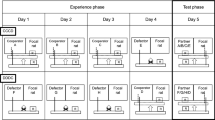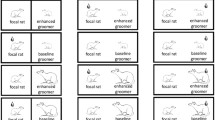Abstract
Direct reciprocity requires the ability to recognize and memorize social partners, and to remember their previous actions. ‘Insufficient cognitive abilities’ have been assumed to potentially impair the ability to cooperate by direct reciprocity. Here we compare the propensity of rats to use direct reciprocity with their ability to memorize and recognize sensory cues in a non-social task. Female rats enriched in one of three sensory modalities (visual, olfactory or auditory) performed better in a learning task when they were tested with the specific sensory modality in which they have been enriched. For the cooperation test, during three subsequent reciprocity experiments the rats could provide two partners differing in their previous helpfulness with food. Individuals performing better in the non-social learning task that involved olfactory cues applied direct reciprocity more successfully in one experiment. However, in the experiment preventing visual cues and physical contact, rats applied direct reciprocity rules irrespective of their performance in the learning task with olfactory cues. This indicates that an enhanced olfactory recognition ability, despite being beneficial, is not a prerequisite for the rats’ ability to cooperate by direct reciprocity. This might suggest that when rats have all types of information about their social partner, individuals may apply other criteria than the reciprocity decision rule when determining how much help to provide, as for instance coercion. Interestingly, when all individuals are constrained to mostly rely on olfactory memory, individuals apply direct reciprocity independently of their ability to memorize olfactory cues in a non-social context. ‘Insufficient cognitive abilities’ may thus not be the true reason when direct reciprocity is not observed.





Similar content being viewed by others
Data availability
My data are published in figshare (DataVassilissaDolivo).
References
Andrist CA (2008) Behavioural syndromes in Norway rats (Rattus norvegicus), Master thesis, University of Bern
Barnett SA (1957) An analysis of social behaviour in wild rats. Proc Zool Soc Lond 130:107–152
Bates D, Maechler M, Bolker B, Walker S (2014) lme4: linear mixed-effects models using Eigen and S4. R package version 1.0-6. http://CRAN.R-project.org/package=lme4
Boeckle M, Bugnyar T (2012) Long-term memory for affiliates in ravens. Curr Biol 22:801–806
Breen AJ, Lovie KE, Guerard C, Edwards SC, Cooper J, Healy SD, Guillette LM (2020) Juvenile socio-ecological environment shapes material technology in nest-building birds. Behav Ecol 31(4):892–901
Brown RE (1979) Mammalian social odors: a critical review. Adv Stud Behav 10:103–162
Brudzynski SM (2009) Communication of adult rats by ultrasonic vocalization: biological, sociobiological, and neuroscience approaches. ILAR J 50(1):43–50
Brudzynski SM, Pniak A (2002) Social contacts and production of 50-kHz short ultrasonic calls in 584 adult rats. J Comp Psychol 116(1):73–82
Burn CC (2008) What is it like to be a rat? Rat sensory perception and its implications for experimental design and rat welfare. Appl Anim Behav Sci 112:1–32
Cai R, Guo F, Zhang JP, Xu JH, Cui YL, Sun XD (2009) Environmental enrichment improves behavioral performance and auditory spatial representation of primary auditory cortical neurons in rat. Neurobiol Learn Mem 91:366–376
Calhoun JB (1979) The ecology and sociobiology of the Norway rat. U.S. Dept. of Health, Education, and Welfare, Public Health Service, Bethesda
Carter G (2014) The reciprocity controversy. Anim Behav Cogn 1(3):368–386
Carter GG, Wilkinson GS (2013) Food sharing in vampire bats: reciprocal help predicts donations more than relatedness or harassment. Proc R Soc B Biol Sci 280(1753):20122573
Carter GG, Wilkinson GS (2015) Social benefits of non-kin food sharing by female vampire bats. Proc R Soc B 282:20152524
Carter GG, Farine DR, Wilkinson GS (2017a) Social bet-hedging in vampire bats. Biol Lett 13(5):20170112
Carter GG, Wilkinson GS, Page RA (2017b) Food-sharing vampire bats are more nepotistic under conditions of perceived risk. Behav Ecol 28(2):565–569
Carter GG, Farine DR, Crisp RJ, Vrtilek JK, Ripperger SP, Page RA (2020) Development of new food-sharing relationships in vampire bats. Curr Biol 30(7):1275–1279
Cheney DL (2011) Extent and limits of cooperation in animals. PNAS 108(suppl. 2):10902–10909
Clutton-Brock T (2009) Cooperation between non-kin in animal societies. Nature 462:51–57
Delmas GE, Lew SE, Zanutto BS (2019) High mutual cooperation rates in rats learning reciprocal altruism: The role of payoff matrix. PLoS ONE 14(1):e0204837
Dolivo V, Taborsky M (2015a) Norway rats reciprocate help according to the quality of help they received. Biol Lett 11:20140959
Dolivo V, Taborsky M (2015b) Cooperation among Norway rats: the importance of visual cues for reciprocal cooperation and the role of coercion. Ethology 121:1071–1080
Dolivo V, Taborsky M (2017) Environmental enrichment of young adult rats (Rattus norvegicus) in different sensory modalities has long-lasting effects on their ability to learn via specific sensory channels. J Comp Psychol 131:79–88 https://doi.org/10.1037/com0000063
Dolivo V, Rutte C, Taborsky M (2016) Ultimate and proximate mechanisms of reciprocal altruism in rats. Learn Behav 4:223–226 https://doi.org/10.3758/s13420-016-0236-z
Ducouret P, Romano A, Dreiss AN, Marmaroli P, Falourd X, Bincteux M, Roulin A (2020) Elder barn owl nestlings flexibly redistribute parental food according to siblings’ need or in return for allopreening. Am Nat 196(2):257–269
Engelhardt SC, Taborsky M (2022) Food-exchanging Norway rats apply the direct reciprocity decision rule rather than copying by imitation. Anim Behav 194:265–274. https://doi.org/10.1016/j.anbehav.2022.09.005
Gerber N, Schweinfurth MK, Taborsky M (2020) The smell of cooperation: rats increase helpful behaviour when receiving odour cues of a conspecific performing a cooperative task. Proc R Soc B 287:20202327
Gfrerer N, Taborsky M (2017) Working dogs cooperate among one another by generalized reciprocity. Sci Rep 7(1):1–6
Gheusi G, Goodall G, Dantzer R (1997) Individually distinctive odours represent individual conspecifics in rats. Anim Behav 53:935–944
Hammerstein P, Noë R (2016) Biological trade and markets. Phil Trans R Soc B 371:20150101
Hammerstein P (2003) Genetic and cultural evolution of cooperation. Book series: Dahlem workshop reports: environmental sciences research report 83–93
Jeffery KJ (2007) Do discrimination tasks discourage multi-dimensional stimulus processing? Evidence from a cross-modal object discrimination in rats. Behav Brain Res 183:213–221
Kettler N, Schweinfurth MK, Taborsky M (2021) Rats show direct reciprocity when interacting with multiple partners. Sci Rep 11(1):1–8
Kotrschal A, Taborsky B (2010) Environmental change enhances cognitive abilities in fish. PLoS Biol 8:e1000351
Landers MS, Knott GW, Lipp HP, Poletaeva I, Welker E (2011) Synapse formation in adult barrel cortex following naturalistic environmental enrichment. Neuroscience 199:143–152
Lehmann L, Keller L (2006) The evolution of cooperation and altruism – a general framework and a classification of models. J Evol Biol 19(5):1365–1376
Melis AP, Hare B, Tomasello M (2006) Engineering cooperation in chimpanzees: tolerance constraints on cooperation. Anim Behav 30:381–392
Paulsson NI, Taborsky M (2021) Reaching out for inaccessible food is a potential begging signal in cooperating wild-type Norway rats, Rattus norvegicus. Front Psychol 12:712333
Paulsson NI, Taborsky M (2022) Norway rats help social partners in need in response to ultrasonic begging signals. Ethology 128(12):724–733
Quinones AE, van Doorn GS, Pen I, Weissing FJ, Taborsky M (2016) Negotiation and appeasement can be more effective drivers of sociality than kin selection. Philos Trans R Soc B Biol Sci 371:20150089
R Core Team (2013) R: A language and environment for statistical computing. R Foundation for Statistical Computing, Vienna. http://www.R-project.org/
Rampon C, Tang YP, Goodhouse J, Shimizu E, Kyin M, Tsien JZ (2000) Enrichment induces structural changes and recovery from nonspatial memory deficits in CA1 NMDAR1-knockout mice. Nat Neurosci 3:238–244
Rochefort C, Gheusi G, Vincent JD, Lledo PM (2002) Enriched odor exposure increases the number of newborn neurons in the adult olfactory bulb and improves odor memory. J Neurosci 22:2679–2689
Roulin A, des Monstiers B, Ifrid E, Da Silva A, Genzoni E, Dreiss AN (2015) Reciprocal preening and food sharing in colour-polymorphic nestling barn owls. J Evol Biol 29:380–394. https://doi.org/10.1111/jeb.12793
Rutte C, Taborsky M (2007) Generalized reciprocity in rats. PLoS Biol 5:1421–1425
Rutte C, Taborsky M (2008) The influence of social experience on cooperative behavior of rats (Rattus norvegicus): direct vs generalized reciprocity. Behav Ecol Sociobiol 62:499–505
Salvanes AGV, Moberg O, Ebbesson LO, Nilsen TO, Jensen KH, Braithwaite VA (2013) Environmental enrichment promotes neural plasticity and cognitive ability in fish. Proc R Soc B Biol Sci 280(1767):20131331
Schneeberger K, Dietz M, Taborsky M (2012) Reciprocal cooperation between unrelated rats depends on cost to donor and benefit to recipient. BMC Evol Biol 12:41
Schneeberger K, Röder G, Taborsky M (2020) The smell of hunger: Norway rats provision social partners based on odour cues of need. PLoS Biol 18(3):e3000628
Schweinfurth MK, Taborsky M (2018a) Norway rats (Rattus norvegicus) communicate need, which elicits donation of food. J Comp Psychol 132:119–129
Schweinfurth MK, Taborsky M (2018b) Relatedness decreases and reciprocity increases cooperation in Norway rats. Proc R Soc B Biol Sci 285(1874):20180035
Schweinfurth MK, Taborsky M (2020) Rats play tit-for-tat instead of integrating social experience over multiple interactions. Proc R Soc B 287(1918):20192423
Schweinfurth MK, Aeschbacher J, Santi M, Taborsky M (2019) Male Norway rats cooperate according to direct but not generalized reciprocity rules. Anim Behav 152:93–101
Stevens JR, Hauser MD (2004) Why be nice? Psychological constraints on the evolution of cooperation. Trends Cogn Sci 8(2):60–65
Stevens JR, Cushman FA, Hauser MD (2004) Evolving the psychological mechanisms for cooperation. Annu Rev Ecol Evol Syst 36:499–518
Szipl G, Boeckle M, Wascher CAF, Spreafico M, Bugnyar T (2015) With whom to dine? Ravens’ responses to food-associated calls depend on individual characteristics of the caller. Anim Behav 99:33–42
Taborsky M, Frommen JG, Riehl C (2016) The evolution of cooperation based on direct fitness benefits. Phil Trans R Soc B 371:20150472
Taborsky M, Cant MA, Komdeur J (2021) The evolution of social behaviour. Cambridge University Press, Cambridge
Trivers RL (1971) The evolution of reciprocal altruism. Q Rev Biol 46:35–57
Veyrac A, Sacquet J, Nguyen V, Marien M, Jourdan F, Didier A (2009) Novelty determines the effects of olfactory enrichment on memory and neurogenesis through noradrenergic mechanisms. Neuropsychopharmacology 34:786–795
Wood RI, Kim JY, Li GR (2016) Cooperation in rats playing the iterated Prisoner’s Dilemma game. Anim Behav 114:27–35
Xu JH, Yu LP, Cai R, Zhang JP, Sun XD (2009) Early auditory enrichment with music enhances auditory discrimination learning and alters NR2B protein expression in rat auditory cortex. Behav Brain Res 196:49–54
Yokoyama S, Radlwimmer FB (1998) The “five-sites” rule and the evolution of red and green color vision in mammals. Mol Biol Evol 15:560–567
Acknowledgements
We acknowledge financial support of the SNF (project grant 310030B_138660 to Michael Taborsky) and of the SAV (grant to Vassilissa Dolivo).
Author information
Authors and Affiliations
Corresponding author
Ethics declarations
Conflict of interest
The authors have no competing interests.
Ethics statement
The procedure described in this manuscript conforms to the legal requirements of Switzerland and the guidelines of the University of Bern, where the work was carried out (licence number BE98/11).
Additional information
Publisher's Note
Springer Nature remains neutral with regard to jurisdictional claims in published maps and institutional affiliations.
Rights and permissions
Springer Nature or its licensor (e.g. a society or other partner) holds exclusive rights to this article under a publishing agreement with the author(s) or other rightsholder(s); author self-archiving of the accepted manuscript version of this article is solely governed by the terms of such publishing agreement and applicable law.
About this article
Cite this article
Dolivo, V., Engqvist, L. & Taborsky, M. When deciding to cooperate by direct reciprocity, Norway rats sometimes benefit from olfactory competence and seem not impaired by insufficient cognitive abilities. Anim Cogn 26, 1119–1130 (2023). https://doi.org/10.1007/s10071-023-01754-5
Received:
Revised:
Accepted:
Published:
Issue Date:
DOI: https://doi.org/10.1007/s10071-023-01754-5




